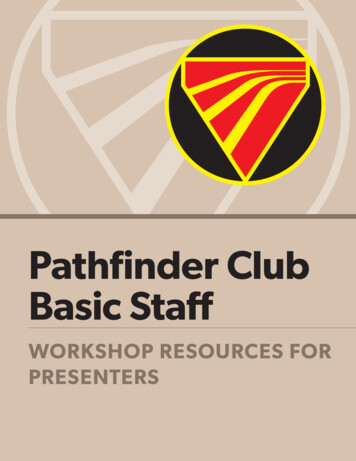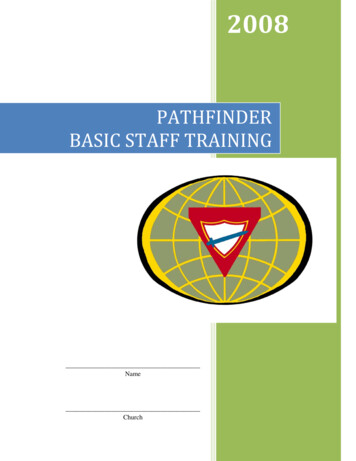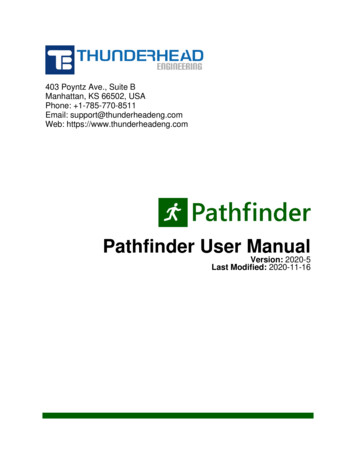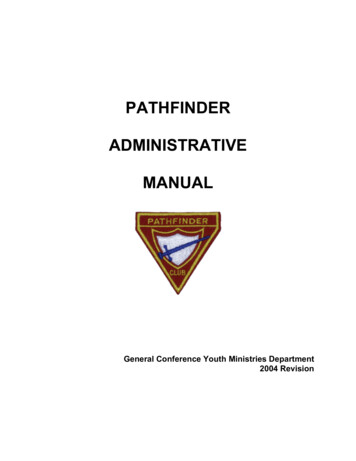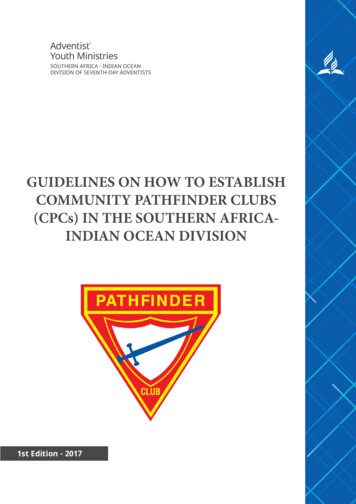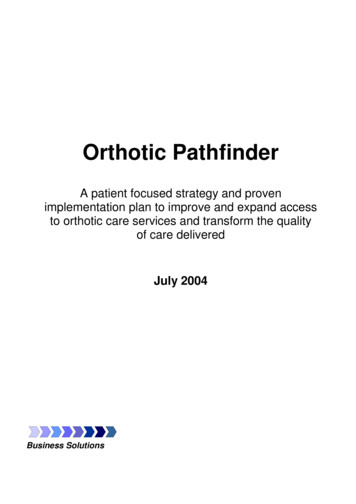
Transcription
Orthotic PathfinderA patient focused strategy and provenimplementation plan to improve and expand accessto orthotic care services and transform the qualityof care deliveredJuly 2004Business Solutions
ContentsForwardBusiness SolutionsExecutive summary55&66IntroductionChapter 11.11.2Chapter .32.32.3.12.3.2Chapter nd to pathfindersOrthotic services: the real ‘Cinderella service’?Why pathfinder?Pathfinder processPathfinder sitesSelection of pathfinder sitesDescriptions and status pre pathfinderA profile of the orthotic pathfinder clinicsReferral pathwaysManagement and reportingConclusions – the problems to be addressedWhat did we do?Phase 1: analysisPhase 2: implementationPhase 3: Following through in pursuit of level 3 benefitsCreating clinical informationThe “hole in the data”A catalyst for changeImproving orthotic servicesTop ten tips for improving orthotic servicesLocal clinical staff reaction to proposed changesOrthotistsOrthopaedic 35353536363637
Chapter pter 5The consequences of poor care provision inpathfinder clinics38For patientsLevel 1 – poor care provision within the clinicLevel 2 – poor accessLevel 3 - changes in budgetary/structuring of orthotic clinicsFor the NHSLevel 2 - Wasted primary care clinician timeLevel 2 - Wasted consultant timeLevel 3 - Increased orthopaedic problems and fallsLevel 3 - Economic consequences of poor care provisionThe Quality Problem38384143434444454546Local response to proposed changes475.15.25.35.4The dilemma of a chronic care specialism in an acute settingAcute trustsPrimary care trustsSocial care47474950Chapter 6Conclusions on likely implementation from a localperspective51Chapter 7Is the service situation in the pathfinderswidespread?53Chapter 8The consequences of poor care provision - anational .3For PatientsLack of patient reviewDelayed care – patients stuck in queuesPatient not receiving careFor the NHSWasted primary care and acute care clinician timeIncreased orthopaedic problems and fallsIncrease whole life care costsFor the commercial sector545455555555555758Chapter 9Conclusions – why has nothing happened?59
Chapter 1010.110.210.310.310.410.5So what is needed and how can it be done?60What is needed?How can it be done?Who needs to do what?What does this mean for the commercial sector?Is change optional?Summary of 345678910Age profile of pathfinder patientsOrthotic patient sample analysisSample pathfinder site – detailed change summaryPatient condition analysisCondition protocol for direct referral (Burton)Sample of patient notes (Burton)Detail of changes proposedExtracts from the national modelClinical reporting – sample outputs from RapportMembership of original working party77788183848788101110111Figures and tables:Figures123The hole in the dataModel for local steering groupDeveloping the commissioning-led approach256466Tables12345678Patient numbers and referralsClinics provided and waiting timesTreatment speed and qualityLevel 1: Patient benefitsLevel 2: Patient benefitsTypical pathfinder clinician hours saved per annumLevel 3 benefitsNational impact – who pays the cost and secures the benefit?1819203841444657
Orthotic PathfinderJuly 2004ForewordThe NHS is undergoing radical change to become a more modern, patient-focused service. Thisis in order to meet the Government’s vision, where patients are seen promptly, in the right place,and by a clinician with the right skills. This report summarises the work of the orthotic servicespathfinder project, jointly funded by the NHS Modernisation Agency and the NHS Purchasingand Supply Agency. It demonstrates the benefits that can be achieved when the NHS thinksdifferently about how it delivers care to patients.The report establishes that there is a clear and attainable opportunity not only for patients butalso for the NHS and social care to rethink their services to achieve significant benefits. Forpatients, speeding up access to orthotic care by ensuring appropriate care is given at the righttime has a dramatic effect, particularly with elderly patients, in keeping them mobile andindependent. This has the additional benefit of reducing the probability of falls in the elderlypopulation. For the NHS, this better care means fewer patients will require orthopaedic care andexpensive post-fall treatments, releasing valuable consultant resources. For social care, fewerpeople will require expensive supported care in the community.People directly involved in the delivery of orthotic care to patients are fully signed-up to thechanges needed. However, those who hold the purse strings are unable to move the fundsaround the NHS and between the NHS and social care in order to make the changes happen.The proposals therefore advocate a whole system approach to change that requires acutetrusts, primary care trusts, strategic health authorities and local social care services to workeffectively together to deliver improved services to patients.The report raises some serious issues around how the NHS treats patients with chronicconditions. The report proves that the ongoing nature of care required by orthotic patients isbetter suited to a primary care led service, but it is buried in the acute care system. To changethis requires a whole system, step-change approach – an approach that may well apply to manyother services providing care to chronic patients. The report contains examples of good practiceachieved in the six pathfinder trusts, sets out how these changes can be delivered across theNHS and signposts the way to delivering better, more timely orthotic care for the circa 1.2 millionpatients who depend on the service for their well-being.The six Pathfinder Orthotic Services were reviewed 12 months after the pathfinder supportteams left. The structural, organisational and budgeting pressures, which prior to pathfinderrestricted the orthotic services re-emerged and crushed much of the pathfinder improvement. Itis clear that without sustainable structural change to service delivery, the orthotic service cannotbenefit from the major improvements identified and orthotic patients generally will becondemned to either no care or poor care. (see page 11-12 for details)We worked in the orthotic service for 3 years to produce this report with committed, dedicatedfront line clinical and administrative staff. The key improvements in patient care would not havebeen possible without their efforts - often in difficult circumstances, in the face of resistance from“the system” and with little thanks – other than from patients. This report is dedicated to them.Philip Boxer & Tom Flynn, Business Solutions5
Orthotic PathfinderJuly 2004Executive summaryIntroductionFor many years NHS orthotic services have been a poor relation in healthcare delivery, hiddenaway in the secondary healthcare system and behind the ‘commercial wall’ that results frombeing a largely outsourced clinical service. Patients have rarely complained and those mostclosely associated with delivering the service (orthotists) are unable to challenge the situationfor fear of losing their commercial contracts. As a result the service has come under increasingpressure to both survive and deliver quality care to patients and is simply not acknowledged forwhat it can do for patients.Periodically, the problems have been forced into the limelight through a series of reports, all ofwhich were heavily critical of the service but none were able to recommend viable solutions. Asa result the problems have continued to worsen. Despite the best efforts of clinical staff andsome managers to improve things, usually in the face of adversity, the statement that, “NHSorthotics services are rudderless and one in which informed management, service audit andstrategic planning have little place", is as true today as it was when the ‘Salford Report’1 waspublished over ten years ago. The report by the Audit Commission2 (2000) further highlightedthe inadequacies of the service and despite making a number of recommendations; little hadchanged by the time the report was followed up in 2002. Ministers have also taken an interestin the service from time to time and have been equally critical of the service being provided topatients. So why is it that change is not happening? And what is the real value thatorthotic services can bring to patient care?This report differs from previous reports in that it describes a project that was designedto deliver the changes necessary to improve patient care rather than merely comment onthe state of existing services. The outputs of the project are reflected in this report, whichdescribes the experiences of six trusts as they went through a process of change and thebenefits that can be achieved if these changes are rolled out across the rest of the NHS.However, the report also highlights the structural changes that are needed to modernise theservice, which proved difficult and in most cases impossible to implement in the pathfinder sites.The report, as well as highlighting operational changes, recommends that structural andfinancial changes are essential to improving care for patients. Without these structural andfinancial changes the pathfinders have demonstrated that the service improvementscannot be delivered.The report is intended not only to force the debate for change, but also to demonstrate thebenefits of change and to serve as a resource for those working to develop local solutions tolocal problems. We hope the information it contains can be widely shared, explored andevaluated both within and beyond the orthotic community.12Salford ReportAudit Commission (2000) Fully Equipped6
Orthotic PathfinderJuly 2004The project commenced in February 2002. For the next 12 months, the project team workedwith six pathfinder sites to modernise and improve access to orthotic services, by delivering aseries of changes aimed at redesigning the service around patients. The objective was toimprove the provision of orthotic care services for patients, with a key priority to improve access.Pathfinder services achieved this objective and greatly improved patient care. However, as thework evolved, it became clear that the budgetary constraints and lack of referral access toorthotic care in many regions by primary care clinicians, combined with the limited GPawareness as to what the orthotic service can provide, was resulting in the underuse3 of theservice, with many elderly patients not receiving essential orthotic clinical care. It is believed thatthis lack of treatment is a contributor to partial or total loss of mobility for a significant number ofpeople, particularly people with diabetes and the elderly. A step-change is needed in theapproach to providing orthotic care in order to address this underuse.The report details the specific changes made to improve the access to and clinical effectivenessof orthotic clinics. The report recommends a mechanism under which targeted transitionalfunding should be made available through strategic health authorities to enable them tointroduce the step-changes needed. Delivering the changes will mean an expansion in orthoticcare that requires budget revisions between health and social care.What is the problem? Orthotic care is a predominantly primary care service for chronic conditions locatedusually within acute trusts. Orthotics does not contribute directly to current acute care key performance indicatorsand has been severely budget constrained for many years as a result. There has been little management focus on the orthotic service.The orthotic service has consequently suffered from being a low priority service deprived ofresources and has struggled to deliver a clinically effective and high quality service in the face ofgrowing demand. The result has been underuse of orthotic care provision, lack of developmentof referral relationships between clinicians, but most notably a lack of service access to GPs,and their primarily elderly patients. As a result, patients do not receive appropriate orthotic careat the right time, and many patients who could have been stabilised by orthotists, suffer seriousloss of mobility. In particular, the elderly suffer more problems, rapidly lose mobility and oftenend up requiring more acute intervention for mobility problems (for example, hip replacements)and frequently for falls. Additionally, lack of referral access for podiatrists for appropriatefootwear results in delayed referral, which, if avoided would reduce acute care, in-patient stays,drugs, amputations etc. and podiatry, nursing and social support in the community. Ultimately,many elderly patients lose their mobility and require expensive social care services. Notproviding access to orthotic care in a timely manner also has the effect of wasting scarce andvaluable clinical resources such as those provided by orthopaedic consultants.3Underuse is the failure to provide a health care service when it would have produced a favourable outcome for a patient. Itcontrasts with overuse, which is the provision of a health care service under circumstances in which its potential for harmexceeds the possible benefit; and with misuse, where an appropriate service is provided, but a preventable complication occurs,and the patient does not receive the full potential benefit of the service. Definitions taken from Crossing the Quality Chasm,National Academy Press 2003, p192)7
Orthotic PathfinderJuly 2004The poor service provision has been recognised by the NHS for many years and numerousreports written highlighting patient problems, the most recent being Fully Equipped4. Thesereports have accurately highlighted the service problems patients face, but not their root cause.Nor have they addressed how/what changes are required, nor most importantly how thesechanges can be implemented given the fragmented nature of the service. So the difficulties inthe service have continued despite their publication.This report identifies the root cause of these continuing problems as structural and financial,caused by the difficulties of making the budgetary changes needed between primary care trusts,acute trusts and social care to correct for this underuse, through altering the funding trade-offsbetween acute and prophylactic forms of intervention.What are the benefits of resolving this problem?For many patients, particularly the elderly, improved orthotic services will have a huge impact onquality of life by enabling them to maintain themselves as independently mobile citizens. Morespecifically, patients will have improved access to care with an estimated 24,000 additionalchronic orthotic referrals per annum and an additional 300,000 chronic patients being underorthotic care within ten years.For acute trusts, many patients currently being referred to consultants will be treated in primarycare. This will free a significant amount of clinical resource for patients who truly need acutecare (saving c 54,000 orthopaedic consultant appointments). Improved mobility provision willhave a major impact on falls, which will also reduce demand for orthopaedic care.The greatest impact both financially and in terms of quality will be on social care, as the numberof elderly patients requiring residential care through loss of mobility and related factors will begreatly reduced. Additionally, better orthotic provision will mean that people who ultimately dorequire residential care will remain independent and enjoy a greater quality of life for longer. Forthe Government, with the proposed co-ordinated health and social care approach, the quality ofdelivered care will be improved and the ‘health of the nation’, particularly of the elderly, willbenefit. In addition, there will be a major net annual saving to the Exchequer of approximately 40 million after five years rising to 390 million in ten years. As primary care trusts significantlyexpand the level of provision of orthotic care, they will reduce the number of patients referred foracute procedures. This expansion will lead to increases in orthotic budgets, estimatednationally, to be around 15million per annum after five years – a small cost to achieve thesignificant social and financial benefits available.Why change?The pathfinders have identified that significant improvements can be made by delivering care topatients promptly, in the right place, and by the right clinician with the right skills. Therecommended changes are very much in accord with the Government’s reforms for the NHS.For example:4Audit Commission (2000) Fully Equipped8
Orthotic PathfinderJuly 2004 The need to redesign services around patients rather than organisations (Delivering theNHS Plan, April 2002) Reducing waiting times for outpatient appointments (Delivering the NHS Plan, April 2002) Reducing the waiting times for hospital operations (Delivering the NHS Plan, April 2002) Extending intermediate, home care and residential care provision to offer alternatives tounnecessary hospital admissions and reduce delayed discharges (Delivering the NHSPlan, April 2002) Patients, particularly older people, need health and social services to work together.They rely on good integration between the two to deliver the care they need, when theyneed it. If patients are to receive the best care then the old divisions between health andsocial care need to be overcome (Delivering the NHS Plan, April 2002) The NHS, working in partnership with councils, needs to take action to prevent falls andreduce resultant fractures or other injuries in their populations for older people (Standardsix: National Services Framework for Older People) Integrated strategies for older people aimed at promoting good health and quality of life,and to prevent or delay frailty and disability can have significant benefits for the individualand society (Standard eight: National Services Framework for Older People) The implementation of the new financial regime Payment by Results means that orthoticcare delivered to outpatients can no longer be buried in the inpatient costs of deliveringspecialty interventions. It will be in the interests of acute trusts to disentangle the cost ofongoing orthotic care to ensure their HRG costs are efficient and to enable them to focuson making surpluses. As yet HRGs for AHP services are underdeveloped but they willneed to be resolved by 2008.What is needed to achieve change?Delivering the necessary change is about addressing the issue of how a chronic service isfunded and managed. There is a double challenge, not only to manage a chronic service in away that can be held accountable in relation to the impact on whole life costs of patients’ care,but also to provide adequate commissioning mechanisms for this kind of approach.The report recommends that: earmarked finance should be made available for five years, channelled through the strategichealth authorities, enabling primary care trusts either to take over the orthotic service fromacute trusts, or to institute direct funding of the primary care element of their acute orthoticservice (dual funding);a restructuring of longer-term budgets to reflect the change in service provision and reduceddemand for mobility care in social services;9
Orthotic Pathfinder July 2004a dedicated and appropriately skilled resource to support primary care trusts in implementingthe commissioning-led processes needed for instituting dual funding, or transferring theservices under their control where appropriate; and in improving service effectiveness inorthotic clinics, building more effective links with acute trust consultants and other primarycare clinicians to increase patient access to the service.Given the lack of orthotists and increasingly number of female orthotists, who will in manycases have career breaks for families etc expanding the service will require a markedexpansion in the training of orthotists, to ensure that there are sufficient trained staff.The project team believe that systemic changes of this kind will not be prioritised by primarycare trusts unless they sit within the larger context of strategic health authority plans for chronicservices, of which orthotics is just one part. Approached through the strategic health authorities,however, orthotics can be used to establish new commissioning and IT infrastructure andprocesses that can be extended across all chronic services.Top Ten TipsThe report recommends ten key areas of change. These are identified in chapter three of thisreport. The pathfinder experience has shown that it is difficult to implement some of thesechanges without addressing the re-structuring of longer-term budgets.What will happen if there is no Structural Change to currentservice provisionTwo approaches had been taken with PCTs by the pathfinders. Where the service had beenrelatively small, it could be transferred directly to the PCT, providing a service back to the AcuteTrust. Where larger, it could use dual funding to ensure that the primary care element of itsservice was properly funded alongside its acute role, which continued to be funded as normal.Although the greatest difficulties had been encountered where transfer of the service had beenattempted, there had been some progress in securing dual funding in two cases. Here differentfunding arrangements had begun to be negotiated for primary care patients to the benefit ofboth the Acute Trust’s waiting lists and the PCT’s costs, as well as to the patients.During Pathfinder implementation, the orthotic service in the six pathfinder trusts greatlyimproved quality of care, raised awareness among referring clinicians and consequently made abetter service available to an increased number of referred patients. When the orthotic serviceswere left to continue the service development, post pathfinder, they all ran into similar difficulties.1.Increased referral rates were maintained as other clinicians were more aware of what theorthotic service could do for patients. Referral rates increased between 15–30% andadditional clinics were set up to respond to the increased patient demand.2.Budgets remained fixed in all the Pathfinder orthotic services between 2003/04 and2004/05. Many of these budgets had already been frozen for several years and werewoefully inadequate for the level of demand pre-Pathfinder. These budgets and themechanisms for setting them do not reflect inflation and certainly do not recognise thegreat increase in demand for the service.10
Orthotic PathfinderJuly 20043.The increased level of referrals and consequent increased costs, although small by thelevels of Acute Trusts, were a problem. Trust management in all cases refused toincrease Budgets and responded to increased patient demand by:Making new patients wait much longer as orthotic queues do not count in acutemanagers KPI performance measures – but budget deficits do.Waiting time for new patients:clinic A : 2 weeks 16 weeksclinic B : 4 weeks 26 weeksclinic C : 7 weeks 28 weeks.Instructing clinical staff not to use new pathfinder clinic facilities, which would allowthem to treat more patients and make better use of their clinical time. Thisprevented clinicians prescribing orthoses to patients and kept down costRefusing to accept referrals from clinicians, on administrative grounds, to keeppatients out of the service and keep costs down. e.g.acute trust orthotic services refused to accept PCT clinician referrals –simply send them back.Acute trust orthotic services refused to accept out of area GP’s referrals forwhom this was the only route to securing orthotic care. These referrals hadbeen previously accepted but there was a need to reduce patient demand.4.Pressure on front line clinical staff increased, as they were expected simply to cope withthe increased workload. Front line clinical staff are being abused by their managers(expected to cope somehow) and are demotivated to see the improvements they workedso hard to achieve reversed because chronic care is simply not a management priority.5.Service improvements were rolled back to respond to pressure on the service. E.g.Patient reviews for all were stopped – restricted only to diabetic/ rheumatoid.Clinical protocols as to what could be delegated were stretched as staff tried torespond to the needs of patients in a situation made increasingly more pressured.6.PCT’s with the many other demands put upon them have not become more involved inwhat is essentially a primary care service. Where the PCT’s were:Talking about taking over a service, nothing has happened.Planning to increase the budget allocated to a service, nothing has happened.In some instances there remains talk, 12 months later, but little action.In some instances referring clinicians, especially consultants, wrote to managers complainingabout the worsening situation in the Orthotic Service, as their patients are have to wait longerand receive less effective care, but this has had little effect. Other clinicians are reallocatingsome of their own hard pressed clinical budget to the Orthotic Service, as the orthotic delays arecausing such a problem to their patients – particularly true for paediatric services.Patient complaints increased greatly as waiting lists have been systematically increased. In oneservice, this resulted in patients’ complaints increasing to such a level that they have complaintforms prominently displayed. Formal patient complaint forms are being completed by 20% ofpatients, with this percentage increasing steadily as queues get longer. To quote one patient:11
Orthotic PathfinderJuly 2004“To keep me waiting 6 months for an insole seems a crime”12
Orthotic PathfinderJanuary 2004Chapter 1: Background to the pathfinders1.1Orthotic services: the real ‘Cinderella service’?Over 1.2 million people (2% of the UK population) suffer from chronic diseases for which theyare currently receiving orthotic care, and yet the service has historically had a very low profilewithin the NHS. As mortality rates are generally low with chronic diseases, orthotic servicessuffer from not being a key performance target. In line with other largely outpatient basedservices it does not occupy a high profile in acute trusts or amongst service commissioners – ifindeed commissioners are even aware that the service exists. However, orthotic services canplay a significant role in keeping people mobile and independent, deferring the need forexpensive surgery or social care services, but awareness and access to the service are poorlydeveloped.Clinician awareness of the service is generally relativelypoor. Having such a low clinical profile is compoundedfurther by the fact that the majority of orthotists arecommercially employed and are therefore viewed as privatecontractors by hospitals, so the clinical benefits of orthoticservices are rarely championed.Orthotic budgets are rarely separately identified andmanagement tends to be hands-off with managers onlyintervening if problems arise - usually because the budget isperceived to be running out of control. Commissioners tendto be unaware of the service’s existence as it is fundedthrough specialty service level agreements such as those fororthopaedics and rheumatology.Demand for the service is growing largely because ofchanging demographics (the majority of orthotic patients areelderly - see Appendices 1 and 2)Box 1Access problem: in onepathfinder trust it wasestablished that a patientwaited 24 weeks to see anorthopaedic consultant afterbeing referred to an outpatientclinic by her GP, and a further12 weeks to see an orthotistafter the consultant referred herto the orthotic clinic. Thisrepresents a wait of 36 weekswhen all that was prescribedand needed was an insole forher shoeThe poor service provision has been recognised by the NHS for many years and numerousreports written highlighting patient problems, the most recent being Fully Equipped5. Thesereports have highlighted the service problems, but the difficulties have continued despite theirpublication. This report concludes that the root cause of these continuing problems is systemic.Budgetary changes are required between primary care trusts (PCTs), acute trusts and socialcare to fund the trade-off between acute and prophylactic forms of intervention to correct theunderuse of the service.These service problems spill into the commercial sector. Commercial providers of orthotists andorthotic products have struggled to cope with the situation and have tended to be viewed with5Audit Commission (2000) Fully Equipped13
Orthotic PathfinderJuly 2004distrust by the NHS and an easy target for savings. Commercial contracts have tended to bebased on inputs rather than on outputs reflecting the lack of management data that is needed todeliver improved health outcomes for patients. The result has been commercial sectorinstability and very low margins, which in turn results in a lack of innovation and research.Difficulties in establishing orthotics in its rightful place are a consequence of its history.Orthotists have practised both within and contracted to the NHS for over 50 years. They wereone of the first of the allied health professions to have an honours degree qualification andbecame state registered in 1997. Despite this, the profession suffers from a lack of recognitionthroughout the NHS. Whilst this is changing, the ‘commercial contractor’ status of the majority oforthotists precludes them from being fully integrated into NHS healthcare delivery and thus thepace of change is slow. Primary care clinicians are only just becoming aware of the potential ofthe service but the vast majority of GPs are simply unaware of what the service can
Orthotic Pathfinder July 2004 7 The project commenced in February 2002. For the next 12 months, the project team worked with six pathfinder sites to modernise and improve access to orthotic services, by delivering a series of changes aimed at redesigning the service around patients. The objective was to
